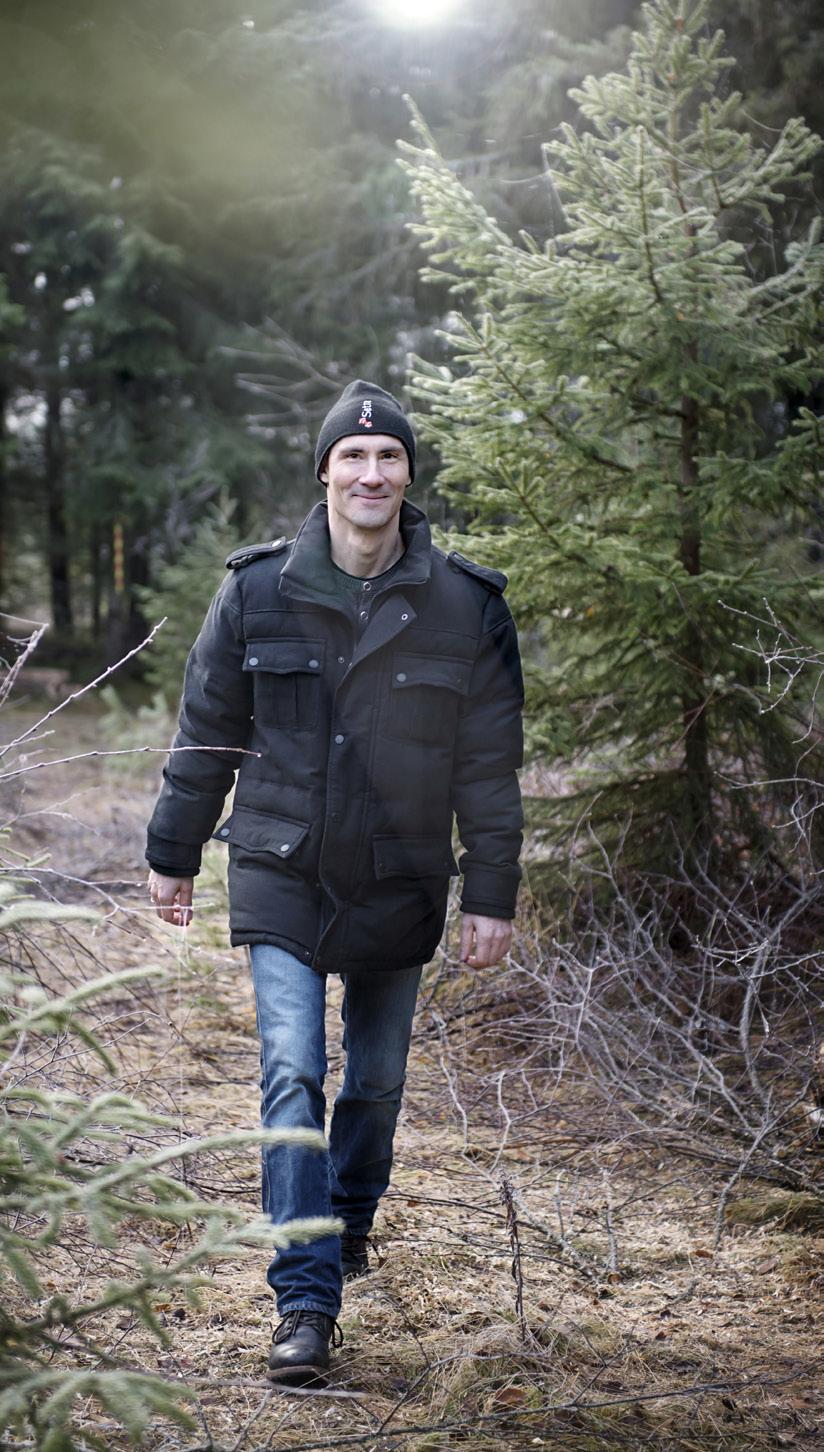
12 minute read
Climate-smart raw material
Responsibility for the raw material at every stage
The wildfires that struck the forests of Hälsingland in summer 2018 were a real trial, not least for the forest owners who saw much of their holdings go up in smoke. It was a huge relief for those affected, when Setra’s plant in Färila stepped in to saw the fire-damaged logs. An undertaking that would continue well into 2019.
Climate-smart raw material Sustainable transport
ALMOST TWO years have passed since the forests of Hälsingland suffered extensive wildfires. People were forced to flee their homes and the fire and rescue service fought tirelessly for weeks against a fire that would turn out to be the biggest in modern Swedish history. The area of forest damaged in the municipality of Ljusdal amounted to around 8,000 hectares, a significant proportion of which belonged to Sveaskog and members of Mellanskog, who jointly own the majority of Setra’s shares.
“Visibility was poor and there was smoke everywhere, when we heard that we would have 25 minutes to leave our house if the fire came any nearer. At that point, I could see that it was serious, but I had no idea what lay ahead of us,” relates Mattias Forslund, Mill Manager at Setra’s sawmill in Färila.
Like a military operation The sawmill’s local management team quickly convened a crisis meeting. They drew up a plan for the worst-case scenario and what action they would take if the fire reached a certain point, close to the sawmill. The Swedish Civil Contingencies Agency needed to use Setra’s site for its countermeasures. The area was cleaned up and in just a few hours it was essentially transformed into a disaster control centre.
“It was obvious to us that we should help deal with the wood and recover as much value as possible. Our owners Sveaskog and Mellanskog were hit hard by the fires and our plant in Färila is only 25 km from the main sites affected,” says Mattias Forslund.
The intervention came to resemble a military operation and faced a number of challenges – not least logistically, since the fire-damaged logs could not be mixed with the existing stock.
A few weeks after the fires had been put out, Setra Färila was ready to start sawing damaged logs and keep them separate from the rest of the production. At the beginning of December 2018, the regular intake of spruce was stopped and work began on the firedamaged logs.
“One of the many challenges was getting a clear idea of the scale. The initial figure was over 200,000 cubic metres solid volume, which for us is more than half a year’s production. However, we ended up dealing with 130,000 cubic metres,” says Mattias Forslund.
No time for detailed planning While the fires were ongoing, Setra Färila had received indications from Mellanskog and Sveaskog that the majority of the fire-damaged wood was pine. In fact, 80% of the wood turned out to be pine. This represented a major undertaking for a sawmill that usually only saws spruce and does not have a prepared market for pine products.
During both the fires and the sawing of the fire-damaged logs, Setra’s raw material coordinator Magnus Olsson worked closely with Mattias Forslund in Färila. Magnus was on site early and remembers the devastation in the fire-hit area.
“It can best be described as a lunar landscape. Everything was so fiercely burned that gravel, rock and black soot were the only things left. In these circumstances, there was no time for any detailed planning. We just had to roll up our sleeves and get to work.
“Sawing fire-damaged logs is a prime example of Grönsamhet. We recovered considerable value in a cost-effective way and managed to produce perfectly good sawn wood products. As the climate changes, extreme weather events are likely to become increasingly common. We now have valuable experience in how to react to unforeseeable situations, which will prove a real strength moving forward,” concludes Magnus Olsson.
Climate change poses a challenge for forestry Global warming is changing the temperature and rainfall patterns that we are used to. Heatwaves lasting several weeks may become common in low-lying areas, increasing the risk of forest fires, as well as damaging seedlings and providing an opening for insect pests and fungi. Increased rain and snowfall will be a challenge in places that already have problems with sea levels, flooding and drainage.
Mattias Forslund, Mill Manager Setra Färila
Bark beetle causes massive damage
Dry and hot summers increase the risk of attack from the European spruce bark beetle, a pest that does huge damage and causes forest owners to lose millions. In 2019, 7 million cubic metres of forest was affected in Sweden, which is double the figure for the previous year.
What is the reason for this increase? There are always bark beetles in the forest. Normally, they attack the dead and half-dead trees, while the healthy ones survive. It’s believed that the attacks we’re seeing now are related to drought and low groundwater levels, which have made the forest less resilient against a mass outbreak.
Why is Setra processing bark beetle-damaged logs? It’s in our owners’ interests to try to recover the value in the forest and we spotted a business opportunity here. We also feel for the landowners and their situation, and it’s important to clear half-dead forest, to stop the outbreaks spreading.
How do you process the wood? Damaged logs require special preparation and must be handled separately and kept apart. We’re setting up a test sawing of bark beetle-damaged wood in order to be well prepared in the event that the volumes increase. The project is both exciting and hard work, and although it’s a commercial risk, we’re learning a lot.
What will the bark beetledamaged wood be used for? The end product may well be construction timber, primarily for the North American market, as long as the wood meets the strength grading requirements. Alternatively, it could be a grade that works for different types of packaging, where the quality requirements are not as high. This type of product is, to some extent, a new niche for us.
Klas Flygare, Manager Bioproducts and Raw Material
Climate-smart raw material
Our raw material comes from forests that are managed responsibly for the benefit of future generations. Every log we use can be traced back to the harvesting site.
Our opportunities and challenges
Setra’s business begins in the forest. We must be able to guarantee that our raw material comes from sustainably managed forests – where economic, environmental and social assets are developed in a balanced way. We therefore value long relationships with our suppliers and only accept logs that are certified or where we can check the origin ourselves.
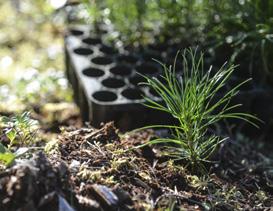
There is huge potential for those of us who work with raw material from the forest and it is growing as new research is conducted into the properties of the material. In a future where wood is set to play an increasingly important role, it will be essential to continue protecting the Swedish forestry model, where we preserve biodiversity while at the same time working to achieve good returns.
Climate change also presents us with new challenges in dealing with damaged wood. We choose to see these challenges as new business opportunities, and a chance to make a significant difference in terms of sustainability.
How we work
Sustainable forestry The Swedish Forestry Act stipulates how we should manage our forests. Sweden imposes an obligation under which reforestation of the land must commence within three years of harvesting, by planting, sowing seed or using seed tree stands. At least two new trees are planted for each one harvested.
The amount of growth is greater than the amount harvested and this was the case for the entire 20th century, which means that there is now twice as much forest in Sweden as there was 100 years ago. Annual growth is put at around 120 million cubic metres of forest, and around 90 million cubic metres is harvested each year.
A key aspect when it comes to silviculture is the capacity of the growing trees to absorb carbon dioxide. Managing the forest is of considerable benefit to the climate, since young, growing trees absorb more carbon dioxide than older ones. When we use the logs to produce wood products, we help to lock in carbon dioxide – stored as carbon – in buildings, for example.
Wood sourcing Setra has no forests of its own and buys in all its timber raw material. Over 99% of our raw material comes from Sweden, with the remaining volume imported from Norway. Setra’s owners Sveaskog and Mellanskog provide a large proportion of the raw timber, and we have around 15 suppliers in total.
In 2019, Setra purchased 3.45 million cubic metres of raw timber, of which 57% was pine and 43% was spruce, often of local or regional origin. Our catchment area is normally within a radius of about 100 kilometres from the sawmill.
Raw material purchasing Setra buys in pine and spruce from around 15 suppliers.
57% PINE
43% SPRUCE
Setra’s timber purchasing includes harvesting and delivery to our mills, with the majority of the wood transported by timber truck. Some of the plants have their own railway track and in 2019 a little over 4% of Setra’s timber arrived by train. We hope to be able to increase the percentage of rail deliveries in the future.
Close supplier partnerships Setra is dependent on getting the right logs to the right sawmill at the right time. The cutting is often tailored to the customers’ wishes actually in the forest. The quality and reliability of the deliveries is incredibly important.
The fact that Setra’s biggest suppliers Sveaskog and Mellanskog are also our owners provides a solid foundation for a secure raw material supply. Sustainable forestry is also a crucial issue for them. State-owned Sveaskog is Sweden’s largest forest owner, and has obtained FSC and PEFC certification for its entire holding of managed forest. Mellanskog is an association owned by 26,000 private forest owners, with around 40% of its forest area PEFC certified.
3.45 million m 3
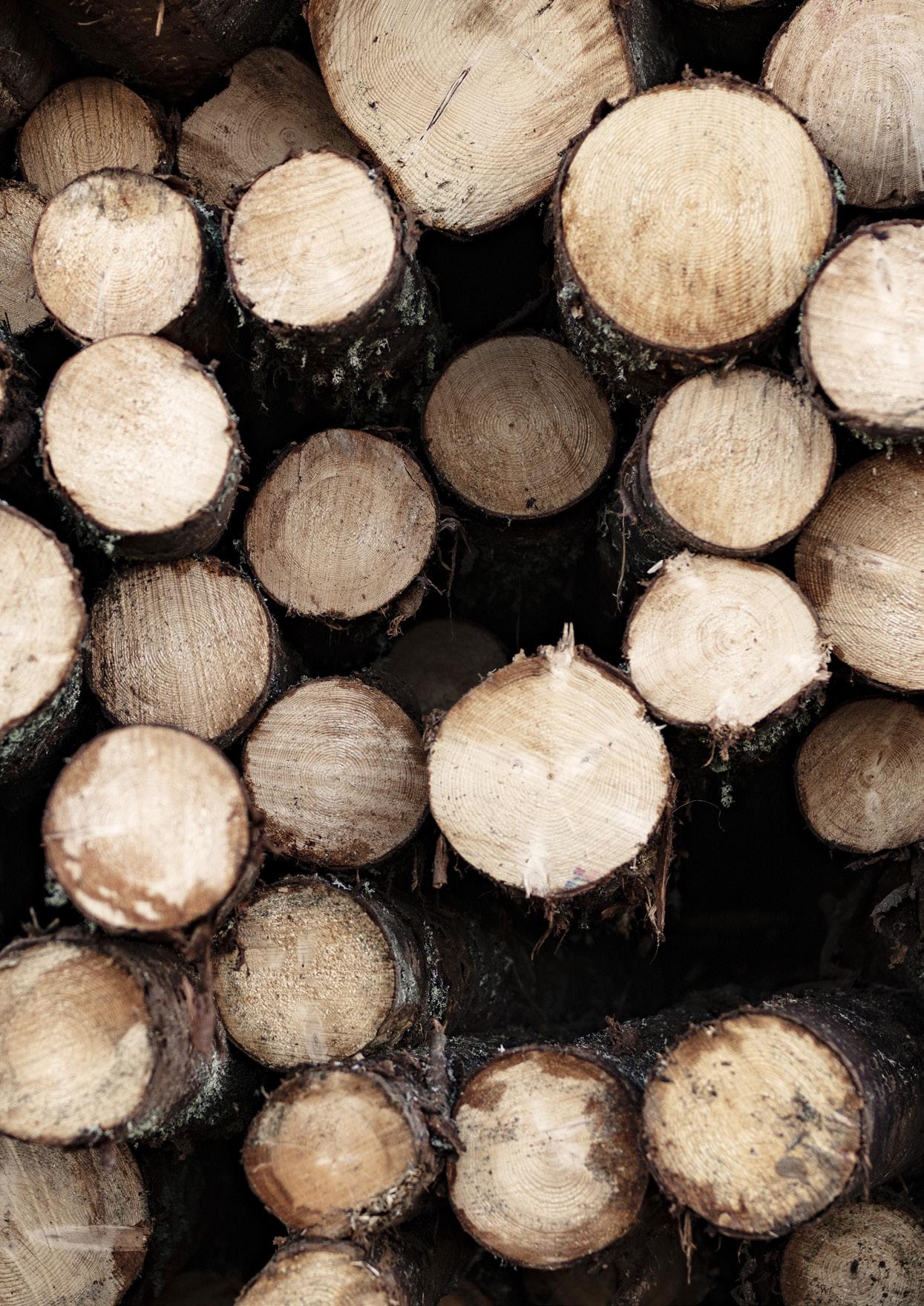
How much raw timber Setra purchased in 2019.
100% All of the wood purchased by Setra is traceable, and meets requirements on controlled raw materials.
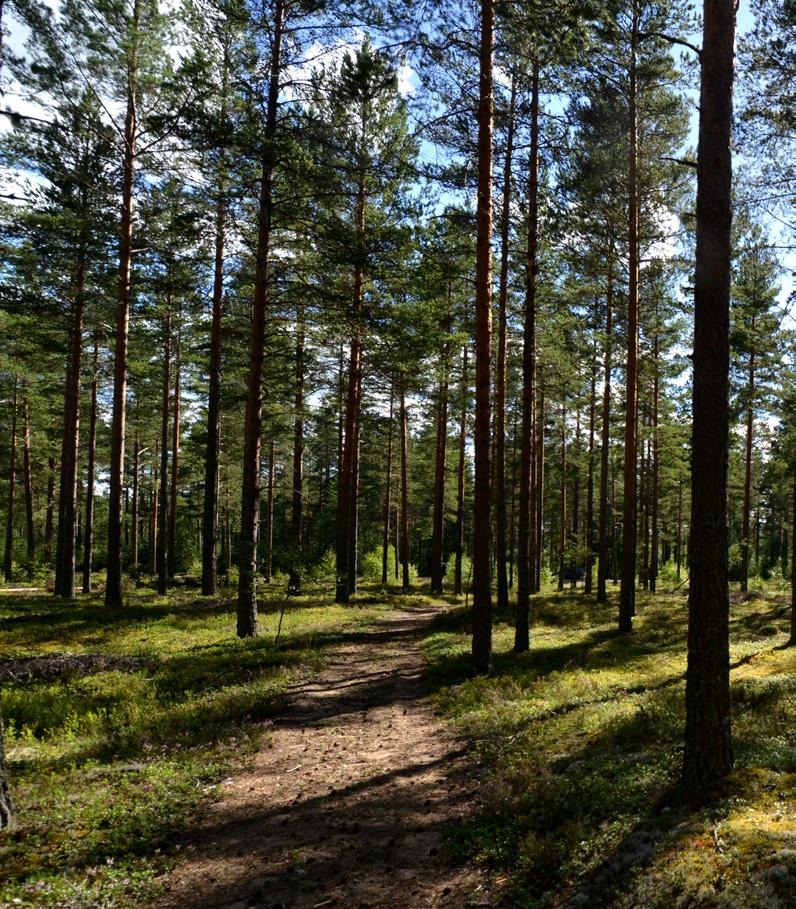
Sales of sawn wood products Certified and controlled, proportion of sales
100 % 100 % 100 % 100 % 100 % 100%100% 100% 100%100%
19%
19% 19%
17% 19%
18%
2015 2016 2017
■ CONTROLLED
20%
20%
2018
23%
20%
2019
Demand for sustainable forestry These days, many people want to know the origin of the wood products they buy. It is becoming increasingly common to require sustainable forestry and certification of the raw material. All but a few of Setra’s raw material suppliers hold FSC or PEFC certification, or both. This means that the forest owner has made a voluntary commitment to responsible and sustainable forestry, and is subject to inspection by third-party auditors.
The minimum requirement for wood supplied to Setra is that the origins are traceable and meet five basic criteria. Setra does not accept: • Illegally harvested wood • Wood from forests with serious social conflict • Wood from forests worthy of conservation • Wood from harvesting that threatens forest assets of high conservation value • Wood from forests in which genetically modified trees are planted
If the timber comes from a certified supplier, it is down to the supplier to check that it meets the requirements. Timber that does not come from certified suppliers is checked by Setra’s own raw material coordinators, for example through supplier visits and follow-up of harvesting.
Setra pays a premium for certified raw material. The amount of certified timber bought in is steered by customer demand, which is steadily rising. In 2019, 43% of Setra’s sold wood products were FSC or PEFC certified, which is a rise of 4 percentage points compared with 2018. At the same time, 30% (22%) of the cellulose chips and 16% (15%) of the biofuel was sold
100 km
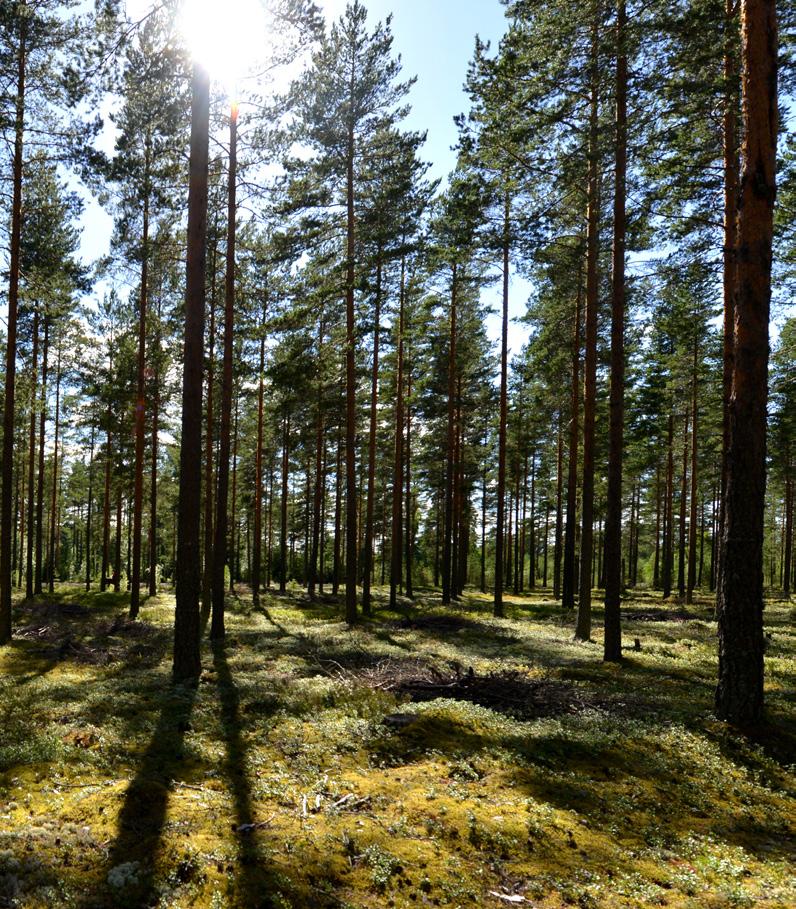
Our raw material comes from forests within around 100 km of the sawmills.
as certified. Demand for certified wood is also strong within the construction industry. The structural elements that Setra is beginning to manufacture in 2020 are produced from certified wood.
Traceability Setra requires transparency and traceability from all our suppliers. Being able to trace the wood back to the harvesting site is essential in enabling us to check that no wood from forest areas of high conservation value is supplied as logs to Setra’s sawmills.
In Sweden, all harvested areas larger than half a hectare must be reported to the Swedish Forest Agency. Using the coordinates of the harvesting site, we can check with the Swedish Forest Agency that the harvesting complies with the regulations in the Swedish Forestry Act and whether any part of the area is protected. We are thus able to trace the wood from harvesting to log sorting at Setra.
Damaged wood For us at Setra, it is important that as much as possible of the forest’s value is realised, both out of respect for nature and for the benefit of the forest owners. We therefore accept timber that is felled in storms or damaged by insects and forest fires. All these are naturally occurring incidents but, as the climate changes, the damage may well become greater and more frequent. Such incidents affect the harvesting in the forest and the reliability of our deliveries, which is why we see a need for greater preparedness in the event of storms, for example.
Certified raw material
PEFC, Programme for the Endorsement of Forest Certification, is an independent umbrella organisation that works for sustainable private forestry through certification by an independent third party. In Sweden approximately 11.5 million hectares of forest land are PEFC certified.
FSC, Forest Stewardship Council, is a non-profit, international, independent organisation of its members that offers a voluntary certification system for responsible forest management. Approximately half of the productive forest land in Sweden is FSC certified.
Governance
All the timber raw material that Setra buys in is either certified or controlled. Certification is carried out in line with FSC® and PEFC™, the world’s largest forest certification systems. The purchasing of wood from suppliers who are not certified is governed by Setra’s raw material policy, which follows the policy for FSC Controlled Wood and PEFC Controlled Sources. This ensures that we also comply with the requirements in the European Timber Regulation.
Setra’s sawmills and processing units are certified according to FSC and PEFC’s Chain-ofCustody standards and FSC’s standard for Controlled Wood.







